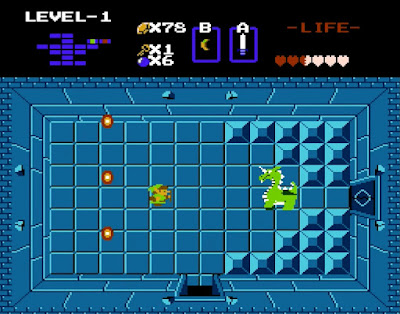Original Release: Feb. 21, 1986, Famicom Computer Disc System. Version Reviewed: NES Classics, 1986. Platform Used: Nintendo 3DS.
THE PLOT:
The peaceful kingdom of Hyrule is invaded by Ganon, the prince of darkness. Ganon kidnaps Princess Zelda, but not before she divides the Triforce of Wisdom into eight pieces, hidden in underground dungeons.
Now it's up to young Link to find the fragments and assemble the Triforce. It will be a long and perilous quest. At the end of it, Zelda awaits rescue - while Ganon awaits his next victim!
...All of that's pretty much from the original game manual (thankfully downloadable online). The game itself gives only the minimum of context before dumping you out onto the world with your three hearts and your wooden sword...
 |
| Link fights enemies on the Overworld. |
GAMEPLAY:
The game is divided into two main settings: The Overworld and the dungeons. You travel one screen at a time. With the exception of the starting screen and shops, each new screen offers bunches of enemies. Evade their attacks, kill them, and collect whatever rupees (cash), health, or bombs drop from them.
In the Overworld, after you've grinded for enough rupees, you can drop by shops to purchase shields, bombs, and health potions. In dungeons, you'll battle your way room by room through waves of enemies. Uncovering secrets (usually hidden staircases) leads you to new items and weapons that will make you stronger. Each dungeon ends with a final boss; after defeating that monster, recovering a Triforce fragment restores your health and returns you to the dungeon entrance.
The entire game follows this basic pattern. It's all very simple. It's also extremely difficult, particularly the last three dungeons. You run into Darknuts, enemies who must be hit from either the back or side to sustain damage... and who have a way of sharply turning to face you just as you're about to attack. Even more aggravating are Wizzrobes, who shoot beams that devastate your health in seconds. Worst are the rooms with Stone Statues: Not only are they firing on you the entire time you're in the room, dodging other enemies; there is no way to disable them.
In short: Dark Souls (which actually isn't as hard as its reputation) has nothing on the original Legend of Zelda.
 |
| Link faces a dragon with his sword and his trusty boomerang. |
THOUGHTS:
After a very brief text introduction, The Legend of Zelda opens with Link on the Overworld. There are three paths he can take, and one cave he can enter. If you send him into the cave, an old man will hand him a wooden sword; if you send link in any other direction, then he will be instantly attacked with nothing at all to defend himself.
This sets the tone for the entire game. Buyers of the NES cartridge in 1987 (and, presumably, 1986 buyers of the Famicom Disc System release) received the benefit of a manual that described the backstory in detail and identified the various items and enemies. Modern gamers, downloading it from the Virtual Console or playing it on the Switch's Nintendo Online service, don't get that benefit. The game leaves you to explore blindly, killing enemies and hoping to stumble across secrets.
I will confess: After a couple hours of aimless wandering, I gave in and resorted to an online walkthrough to get me from one objective to the next. Without it, I would have lost interest and abandoned the game. With it, the game was still difficult... But there was a structure to it, and I knew what I was doing at any given moment. I would heartily recommend any but the most masochistic of gamers do the same.
At a glance, it's hard to see how this game led to such an impressive franchise. It looks and plays much like an old-school arcade game, except that it allows you to save your progress (only when you get killed... though Virtual Console save states allowed me to cheat in this regard).
However, even before I gave in to the temptation of Internet walkthroughs, I found myself really enjoying myself. Hyrule may be very blocky and simplistically rendered, but it's also bright and colorful. The Overworld score is jaunty and the little "beeps" and "whoops" as you kill enemies and collect loot almost act as a counterpoint to that score. The music becomes moodier in the dungeons, and the designers find ways to vary the patterns you use in different settings so that it never gets stale.
OVERALL:
36 years on from its original release, The Legend of Zelda remains an attractive package: Brightly colored sprites, a catchy score, and a mixture of exploration and frenetic combat. It looks primitive, and it takes up a laughable 47 blocks of 3DS memory - Less than half a gigabyte. But its simplicity hides a surprising level of difficulty. A lot of fast movement and on-the-fly strategy is needed to survive and progress, particularly in the late stages.
Incredibly well-made for its time, The Legend of Zelda stands up as a fast-paced, fun reminder of a simpler time in gaming. More ambitious tiles were to come... But this is a game that accomplishes everything it sets out to do, and it can be held up as one of the very best archival video games.
Overall Rating: 10/10.
Next Game: Zelda II - The Adventure of Link
Review Index
To receive new review updates, follow me:
On Twitter:
On Threads:

No comments:
Post a Comment